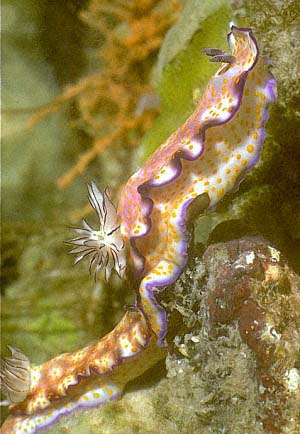
Risbecia pulchella
(Ruppell & Leuckart, 1828)
Order: NUDIBRANCHIA
Suborder: DORIDINA
Family: Chromodorididae
DISTRIBUTION
Indian Ocean. Relatively common in the Red Sea and East Africa. Reported below from southern Thailand.
PHOTO
ALL PHOTOS: Mbudya Is, Dar es Salaam, Tanzania, February 1979. Note characteristic 'tailing' behaviour. 70, 65mm long. PHOTOS: Bill Rudman.
Originally described from the Red Sea, where it coexists with the similarly coloured Risbecia ghardaqana and Chromodoris annulata. See my message comparng these species. In the western Pacific there is another species, Risbecia imperialis, which differs externally only in the absence of the purple border to the foot and the smudged purple reticulate pattern found on the dorsum of this species.
Gohar & Aboul-Ela (1957) studied this species in some detail, and the following paragraph summarises their description of the species. It grows to 10cm fully extended. The mantle is of a somewhat opaque creamy white, marked by a bluish purple tinge in irregular areas on the mantle and sides of the foot. All the dorsal surface of the mantle and the foot is covered with yellowish orange spots of irregular shape and different sizes. The mantle margin is fringed with a thin border of bright bluish violet. The posterior tip of the foot may have a similar border. The front of the mantle forms a veil which continuously waves up and down when crawling. The rhinophores have a white stem and blue leaves. The gills are simple and the colour of the edge can vary from violet to orange yellow in a single specimen. The gills are often branched and wave rhythmically from side to side. When recently spawned, the egg ribbon is reddish orange and it is attached along one edge in a spiral, the free edge being slightly wavy.
These photos show the characteristic 'trailing' behaviour found in all species of Risbecia, where pairs of animals are often found following each other in single file, the second animal in the line usually touching the 'tail' of the one in front. See Erwin Koehler's messages about this behaviour in Risbecia pulchella and Risbecia tryoni.
References:
• Gohar, H. A. F., & I. A. Aboul-Ela. 1957a. The development of three chromodorids (with the description of a new species). Publications of the Marine Biological Station, Al-Ghardaqa, Egypt, 9: 203-228, pls. 1-5.
• Rudman, W.B. (1984) The Chromodorididae (Opisthobranchia: Mollusca) of the Indo-West Pacific: a review of the genera. Zoological Journal of the Linnean Society, 81: 115-273.
• Rudman, W.B. (1987) The Chromodorididae (Opisthobranchia: Mollusca) of the Indo-West Pacific: Chromodoris epicuria, C. aureopurpurea, C. annulata, C. coi and Risbecia tryoni colour groups. Zoological Journal of the Linnean Society, 90: 305-407.
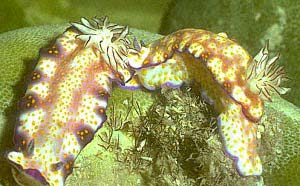
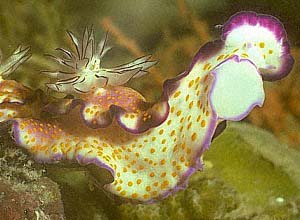
Rudman, W.B., 2003 (April 8) Risbecia pulchella (Ruppell & Leuckart, 1828). [In] Sea Slug Forum. Australian Museum, Sydney. Available from http://www.seaslugforum.net/find/risbpulc
Related messages
Re: Risbecia pulchella at rest
February 24, 2009
From: Ron Velarde
Concerning message #22255:
Dear Valda and Bill,
More than likely the "guard dog" copepods are in fact "guard dog" amphipods.
Ron
rvelarde@sandiego.gov
Velarde, R., 2009 (Feb 24) Re: Risbecia pulchella at rest. [Message in] Sea Slug Forum. Australian Museum, Sydney. Available from http://www.seaslugforum.net/find/22281Thanks Ron,
Best wishes,
Bill Rudman
Risbecia pulchella at rest
February 16, 2009
From: Valda Fraser
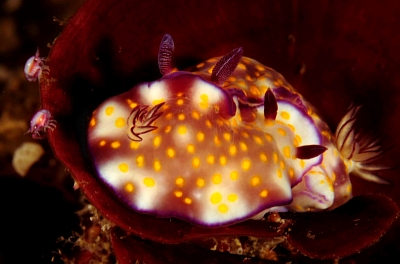
Dear Bill
I loved this pic of cuddled up Risbecia pulchella. Having a snooze after "trailing around ". Notice the "guard dog" copepods.
Locality: Park Rynie, 25 m, South Africa, Indian, 6 Feb 2009, Rocky reef. Length: 40 mm. Photographer: Valda Fraser.
Best wishes
Valda
valdafraser@mweb.co.za
Fraser, V.J., 2009 (Feb 16) Risbecia pulchella at rest. [Message in] Sea Slug Forum. Australian Museum, Sydney. Available from http://www.seaslugforum.net/find/22255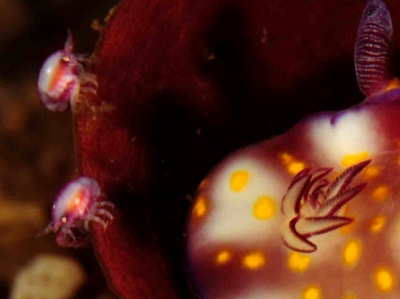
Thanks Valda,
Sometimes its ok to presume they have human attributes. On a more boring matter, would you know if they are nestling in a cup sponge in your photo? If so, did you see any sign of feeding - not that they should feed on such a sponge - but I am trying to be impartial in my collecting of clues to chromodorid feeding.
Best wishes,
Bill Rudman
Risbecia pulchella - Stretching ?
June 6, 2008
From: Kamal El Tawil
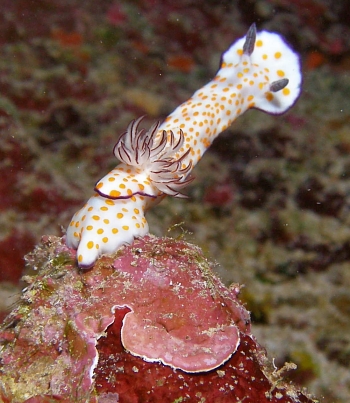
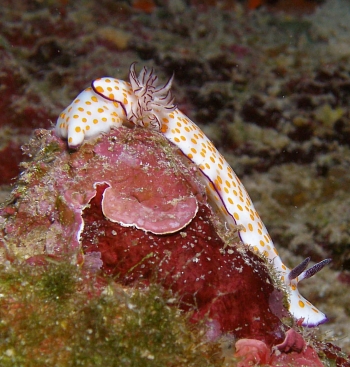
Concerning message #21047:
Dear Bill,
This beautiful Risbecia pulchella was "standing up fully streched" on a coral tip. I have seen other species do the same and I now wonder if there is a reason for this behaviour. After a few minutes it crawled on the reef.
Locality: Elphinstone Reef, 15 metres, Egypt, Red Sea, 27 May 2008. Length: 60 mm. Photographer: Kamal El Tawil.
Kindest regards,
Kamal
www.coralworld.net
kamal@coralworld.net
El Tawil, K., 2008 (Jun 6) Risbecia pulchella - Stretching ?. [Message in] Sea Slug Forum. Australian Museum, Sydney. Available from http://www.seaslugforum.net/find/21625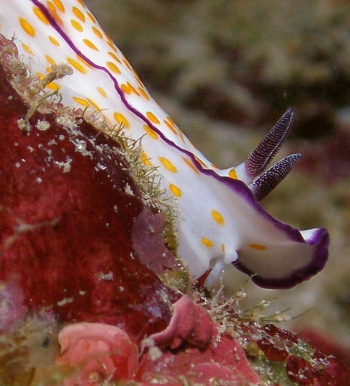
Dear Kamal,
In your earlier message I hesitated to give a reason for that other characteristic Risbecia behaviour - trailing. There is a whole field of research, called ethology, which studies animal behaviour. This 'stretching behaviour' is often seen, but like 'trailing', no scientific research has been done on it. However there seems to be a perfectly reasonable explanation for stretching - but remember it is just an hypothesis. Stretching and waving the head and neck around is seen in many snails and slugs both in the sea and on the land. These animals are essentially blind, so they rely on other senses such as touch and smell to discover where they are. When they are crawling along and reach the top of a rock or the edge of a leaf, they can't see the gap in front of them, but they can certainly feel that they are running out of something to crawl on. So I presume the first aim of stretching is to see if their is something solid nearby which they can move to. In water, stretching and waving the head around also waves the rhinophores, or other chemosensory organs on the head, so they can 'look' for interesting smells, which could mean food or a mate. As you illustrate in your photos, after stretching for awhile and finding nowhere to go, or no smells to investigate, they just settle down and blindly crawl away.
Best wishes,
Bill Rudman
Trailing Risbecia pulchella from the Red sea
April 9, 2008
From: Kamal El Tawil
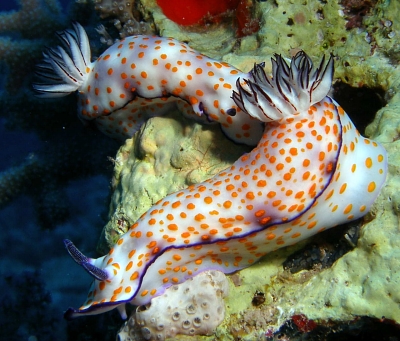
Dear Bill,
Concerning messages #21027 and #21028, I am attaching some pictures of trailing Risbecia pulchella. The animals were moving steadily along the reef.
Locality: Shuab Rumi , 25 metres, Sudan, Red Sea, 12 August 2007, Reef plateau. Length: 100mms. Photographer: Kamal El Tawil.
Kindest regards,
Kamal El Tawil
www.coralworld.net
kamal@coralworld.net
El Tawil, K., 2008 (Apr 9) Trailing Risbecia pulchella from the Red sea. [Message in] Sea Slug Forum. Australian Museum, Sydney. Available from http://www.seaslugforum.net/find/21047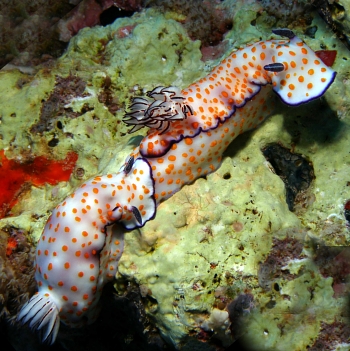
Thanks Kamal,
Trailing is one of those behaviours which we can dream up eminently 'sensible' reasons for, but in reality we have no idea why some species, and sometimes whole genera, do and others don't seem to.
Best wishes,
Bill Rudman
More Risbecia ghardaqana from Thailand?
February 5, 2008
From: K. Kalani Patterson
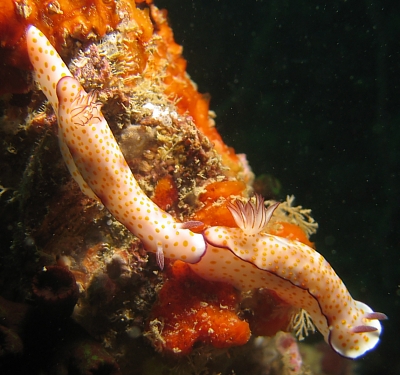
Concerning message #7195:
I believe I have found more Risbecia ghardaqana in Thailand. This pair was spotted at Koh Doc Mai, as island off Phuket, as well.
Locality: Koh Doc Mai, 60 feet, Phuket, Thailand, Andaman Sea, 21 January 2008, Wall. Length: 3 inches. Photographer: K. Kalani Patterson.
K. Kalani Patterson
kalani@kalani.net
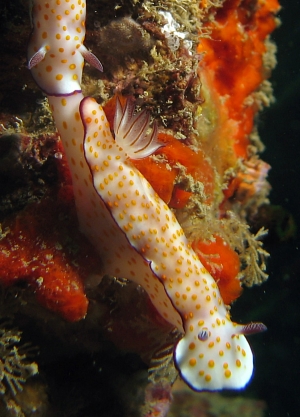
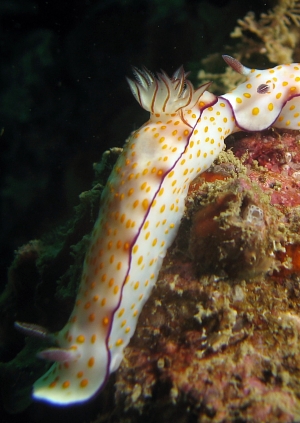
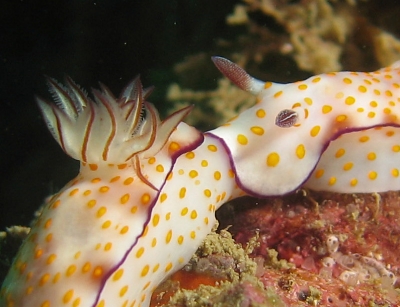
Dear Kalani,
Have a look at Greg Brown's recent message [#20912] which has the most convincing photos of 'true' R. ghardaqana that I have seen. I am afraid your animals with purple smudges on the mantle, a large number of moving gills, and the front the mantle expanded into a wide flap are all characters of R. pulchella and absent in R. ghardaqana. Unfortunately some of the photos on the Forum are difficult to identify to either of these species but hopefully I now have most of the messages concerning then under the right species name. Now that we have Greg's photos as a standard, I am much more confident in saying that your animal is R. pulchella.
It's nice to see them doing their normal 'trailing' behaviour.
Best wishes,
Bill Rudman
Re: Risbecia ghardaqana from Hurghada, Egypt
October 30, 2007
From: Yahia Mokhtar
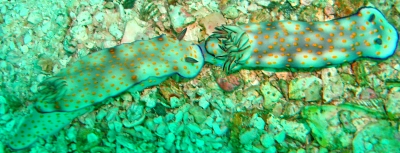
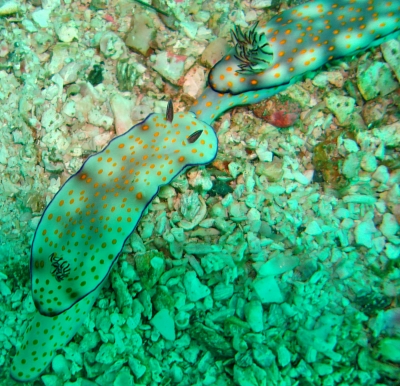
Concerning message #20912:
I think I had a fairly recent photo of Risbecia ghardaqana this weekend on 27 m depth, North of Octopos Rock, Musandam, Oman.
Have a look, and mind the poor illumination, the flash was not effective at this depth at noon.
Locality: Octopos Rock - Musandam, 27m, Oman, Musandam, Indian Ocean, 26 October 2007, gravel. Photographer: Yahia Mokhtar.
Yahia Mokhtar
yahia@adma.ae
Mokhtar, Y., 2007 (Oct 30) Re: Risbecia ghardaqana from Hurghada, Egypt. [Message in] Sea Slug Forum. Australian Museum, Sydney. Available from http://www.seaslugforum.net/find/21028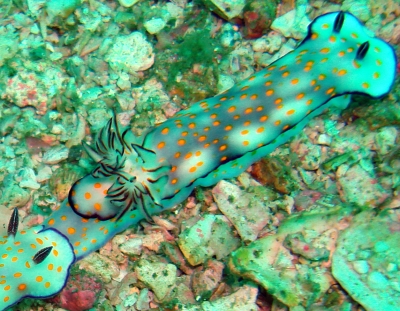
Dear Yahia,
This is not R. ghardaqana but one of the other species of yellow-spotted chromodorid found in your region. It is R. pulchella and your photo alongside shows some of the features which distinguish the two species.
Firstly, in R. pulchella the mantle widens out at the head end to form a sort of lobe as we can clearly see in your photo, while in R. ghardaqana there is no lobe. Similarly your animals have a pattern of smudged purple patches on the mantle which are a feature of R. pulchella but absent in R. ghardaqana. Also in R. ghardaqana there are only a few gills and they do not vibrate rhythmically, while in R. pulchella there are many gills and they do vibrate. In your photo there are many gills, and although we can't be sure in a still photo, they certainly look as though they are waving from side to side.
Until Greg Brown's recent message I was beginning to wonder whether I was ever going to see an animal that fitted the description of R. ghardaqana, so I can assure you that you are not the first person who has mistaken R. pulchella for this species.
Best wishes,
Bill Rudman
Risbecia pulchella from the Red Sea
October 30, 2007
From: Larry Dupriest
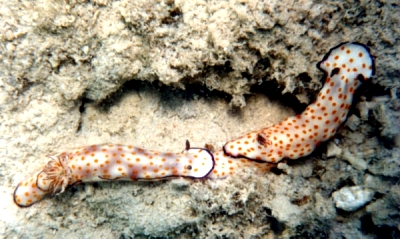
I recently dug through our massive number of underwater photos from Saudi and came across this one.
Locality: Yanbu, 2-3 feet, Saudi Arabia, Red Sea, Oct 2000, Very clear shallow water. Length: abt 2 inch. Photographer: Larry Dupirest.
Like most of Saudi's Red Sea coastline, this is an area where the coral reef parallels the shore about 100 feet out. The reef's edge is a vertical 50 ft drop of live coral teaming with fish varieties. These nudi's were found in the 2-3 feet shallows about half way out to the reef as we snorkeled the area. We watched this pair for about fifteen minutes as they steadily moved across the bottom. From a total novice:
1) Apparently Chromodoris, what is a proper identification?
2) What are they up to?
Thanks
Larry Dupriest
dgdupriest@nctv.com
Dupriest, L.M., 2007 (Oct 30) Risbecia pulchella from the Red Sea. [Message in] Sea Slug Forum. Australian Museum, Sydney. Available from http://www.seaslugforum.net/find/21027Dear Larry,
This is Risbecia pulchella which is one of a number of yellow-spotted chromodorids from the Red Sea region. It is not actually a species of Chromodoris but belongs to the same family. Some members of the family, and it seems some other nudibranchs as well, have this curious behaviour of moving along in single-file often the one behind having its head on the foot of the leading animal. This has been called trailing and tail-gating - have a look at the trailing Fact Sheet from more discussion and examples. We have no idea why they do it, although, of course, there are plenty of theories.
Best wishes,
Bill Rudman
Risbecia ghardaqana ? from Muscat, Oman
September 21, 2007
From: Yahia Mokhtar
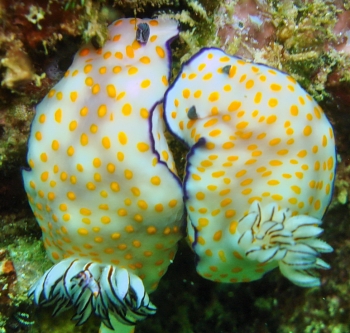
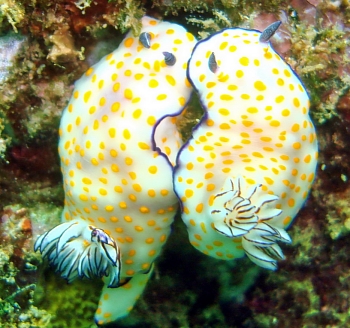
Hi,
The attached photo was taken in Muscat. Seems like a Chromodoris annulata however no 'circles' are present. Could it be a deformed nudibranch, or Chromodoris rufomaculata?
Locality: Town, 10m, Oman, Muscat, Indian Ocean, 2 June 2007. Length: 1cm ??. Photographer: Yahia Mokhtar.
Yahia Mokhtar
yahia@adma.ae
Mokhtar, Y., 2007 (Sep 21) Risbecia ghardaqana ? from Muscat, Oman. [Message in] Sea Slug Forum. Australian Museum, Sydney. Available from http://www.seaslugforum.net/find/20755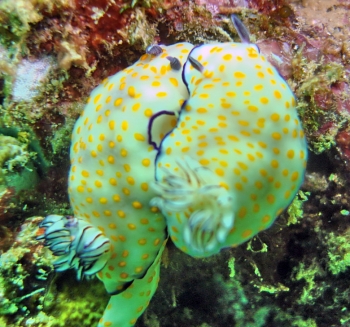
Dear Yahia,
It certainly looks like C. annulata, but there are a group of yellow-spotted species from the northwestern Indian Ocean which are still a problem to identify [see my message #9625]. When I first saw your photos I thought that at last we had photos of Risbecia ghardaqana, which I can't confidently say I have actually seen. In the original description, it was said to differ from the more common Risbecia pulchella in having no purple patches on the mantle, a bluish edge to the mantle, and to not have the broadened mantle skirt around the head end. We can say that your animal fits that description rather well, but the gills are all wrong. In the description of R. ghardaqana there were a maximum of 10 gills, and they did not vibrate or wave rhythmically. In your photos there are more than 20 gills and from the blur in some photos I am pretty sure these gills are waving rhythmically.
I am not sure what is going on so all I can do is say this is probably Risbecia pulchella.
Best wishes,
Bill Rudman
Mating Risbecia pulchella from Tofo, Mozambique
August 24, 2007
From: Natasja Vandeperre
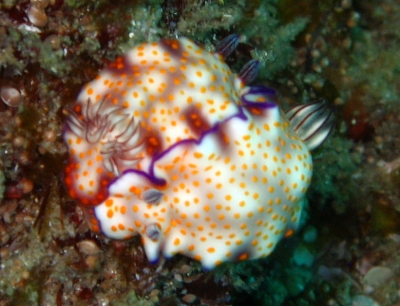
Dear Bill,
Here is a picture of mating Risbecia pulchella from Tofo, Mozambique.
Locality: Tofo, Mozambique, Indian Ocean, 19 July 2007. Photographer: Natasja Vandeperre.
Greetings,
Natasja
postmaster@naaktslakken.be
Vandeperre, N., 2007 (Aug 24) Mating Risbecia pulchella from Tofo, Mozambique. [Message in] Sea Slug Forum. Australian Museum, Sydney. Available from http://www.seaslugforum.net/find/20499Thanks Natasja,
Bill Rudman
Risbecia ghardaqana? from Indonesia
August 18, 2007
From: Grace Wong
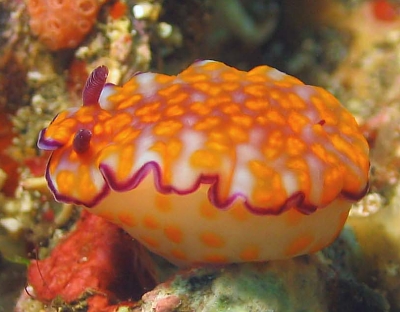
Hi Bill
Thought this might add to your collection. I presume it is juvenile Risbecia ghardaqana? Please advice. Thanks.
Locality: Lembeh Straits, 12-15 m, North Sulawesi, Indonesia, 31 May 2004. Length: About 3 cm. Photographer: Grace Wong.
Grace Wong
gracewym@gmail.com
Wong, G., 2007 (Aug 18) Risbecia ghardaqana? from Indonesia. [Message in] Sea Slug Forum. Australian Museum, Sydney. Available from http://www.seaslugforum.net/find/20166Dear Grace,
As you will see from earlier comments of mine [see also message #9625] I am not entirely convinced I can identify R. ghardaqana. However the authors of that species state most definitely that the background colour is white with no purple patches, so it seems your animal is not that species. Although it is not a usual colour form, I think it is probably Risbecia pulchella, but I may be wrong.
Best wishes,
Bill Rudman
Re: Rispecia ghardaqana? from South Africa
May 9, 2007
From: Colin Ogden
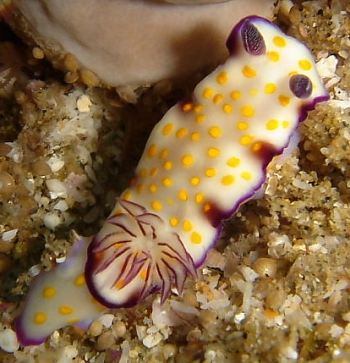
Concerning message #19883:
Hi Bill,
Thanks for your response on the C. cavae. It is fascinating to see all the discussion on the forum generated by a couple of photos. I have a photo here of what I have tentatively ID as a R. ghardaqana as mentioned by you in the previous message. It is fairly similar to the C. cavae, or could it be a Risbecia pulchella.
Locality: Sodwana Bay, 19 metres, South Africa, Indian, 24 june 2006, coral reef. Length: 20mm. Photographer: Colin Ogden.
Regards
Colin
scubaco@iafrica.com
Ogden C. M., 2007 (May 9) Re: Rispecia ghardaqana? from South Africa. [Message in] Sea Slug Forum. Australian Museum, Sydney. Available from http://www.seaslugforum.net/find/19888Dear Colin,
This is definitely R. pulchella. In my earlier summary [#9625], the translucent purplish patches seen in your photo are found in R. pulchella and are absent in R. ghardaqana, which has a uniform white background - apart from other things. To tell the truth I have never seen a specimen - or photo - which I could confidently identify as R. ghardaqana. That is the reason I wondered whether an animal like your C. cavae specimen could have been what Gohar & Aboul-Ela (1957) found and considered to be a new species which they named Chromodoris ghardaqana.
Best wishes,
Bill Rudman
Risbecia ghardaqana? from the Red Sea
July 24, 2006
From: Kamal El Tawil
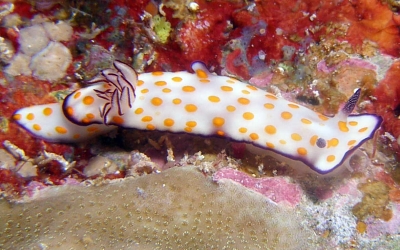
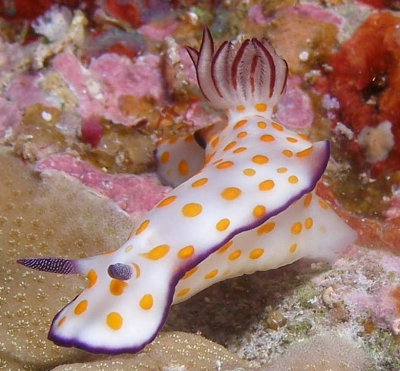
Dear Bill,
Here is a beautiful Risbecia from the Red Sea crawling on coral formations. Is it R. pulchella or R. ghardaqana? The difference is still confusing for me. I turned to your message #9625 and my message #14651. Taking into consideration the nine gills on this nudibranch I identify it as Risbecia ghardaqana.
Locality: Maksour Reef, Fury Shoal, Red sea, 18, Egypt, Red Sea, 10 July 2006. Length: 50-60 mm. Photographer: Kamal El Tawil.
please confirm.
best regards,
Kamal
kamal@coralworld.net
El Tawil, K., 2006 (Jul 24) Risbecia ghardaqana? from the Red Sea. [Message in] Sea Slug Forum. Australian Museum, Sydney. Available from http://www.seaslugforum.net/find/17209
Dear Kamal,
Firstly I am also confused by these two species. If it were not that Gohar & Aboul-Ela (1957) had examined so many specimens and could see clear differences, I would probably have concluded the two were variants of the same species. So I am as keen as you are to find more animals which fit there description of R. ghardaqana. It would also be nice to find egg ribbons of both species, as they note that R. ghardaqana has a white egg ribbon and R. pulchella a red-orange one.
Certainly the small number of gills, and the relatively large yellow spots in your photo, both fit their R. ghardaqana. However they state that the gills in R. ghardaqana are 'non vibratile', that is they don't wave from side to side, and that the front of the mantle doesn't expand into a 'prominent veil'. In your photo the front of the mantle does expand, and the gills certainly look as though they are waving around.
The record on the Forum I am most comfortable with is Barbara Phua's from Thailand #7195. It is a long way from the Red Sea, but it seems the distribution of quite a few species extends across the nthn Indian Ocean from the Red Sea to Thailand. Her animals have few gills, no expanded region at the anterior end of the mantle, and lays a white egg ribbon. I can't be 100% sure, but I think your animal is a relatively small R. pulchella.
Please don't lose interest in this quest. Now that you are familiar with R. pulchella, hopefully when you do find R. ghardaqana, the differences will be obvious.
Best wishes,
Bill Rudman
Risbecia pulchella from the Red Sea
March 6, 2006
From: Kamal El Tawil
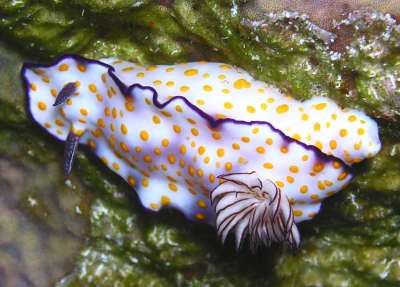
Hi Bill:
Is this a Risbecia ghardaqana? it's about 4cms and it was solitary or could it be a juvenile Risbecia pulchella (beautiful risbecia) ?
Locality: Elphinstone Reef, Marsa Alam, Egypt. Red Sea. Depth: 10 metres. Length: 4 cms. June 24th, 2005. Photographer: Kamal el Tawil
kind regards
Kamal
kt@tedata.net.eg
El Tawil, K., 2006 (Mar 6) Risbecia pulchella from the Red Sea. [Message in] Sea Slug Forum. Australian Museum, Sydney. Available from http://www.seaslugforum.net/find/14651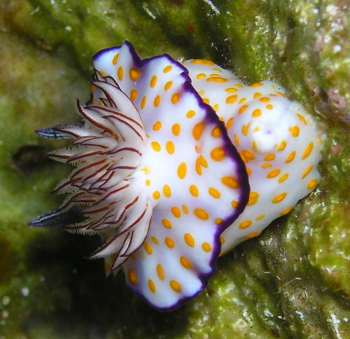
Dear Kamal,
As I discuss in an earlier message [#9625] there are three yellow-spotted chromodorids in the Red Sea and at least two of them - the species of Risbecia - are difficult to tell apart, mainly because we are having difficulty in rediscovering Risbecia ghardaqana. However there is one feature which I haven't considered much in the past, and that is the number of gills. From the many gills in your specimen, I guess it is R. pulchella, both R. ghardaqana and Chromodoris annulata are said to have only 9-12 gills, conpared with the 20-30 in R. pulchella.
Best wishes,
Bill Rudman
Periclimenes imperator on mating Risbecia pulchella
August 3, 2005
From: Matan Ninio
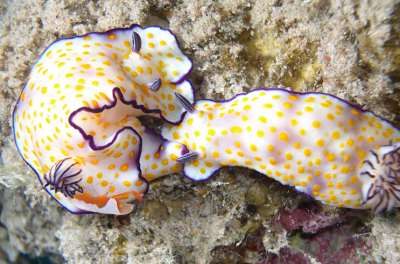
Hi Bill,
Here is one more species to the list of hosts of Emperor shrimps. Images from Eilat, Israel (Red-sea).
Locality: South beach, Eilat. Israel. Red sea. 6 July 2005. Photographer: Raz (rubberduck) Cohen
The full sequence can be found in the Israeli slug forum at:
.
http://www.tapuz.co.il/Communa/ViewmsgCommuna.asp?Communaid=152&msgid=4644664
Matan Ninio
matan@frumhsofiotyam.diving.el.ninio.org
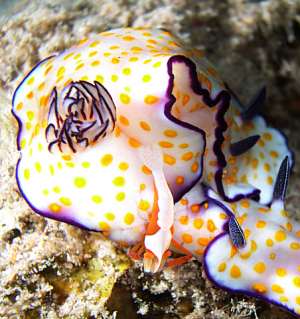
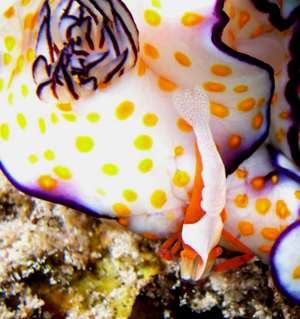
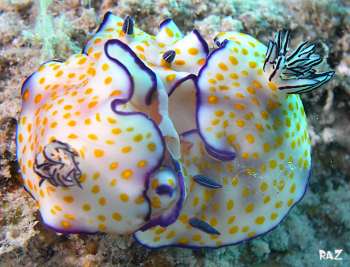
Dear Matan,
Thanks to you and Raz for these photos. I would very much like to see photos of this animal laying eggs. Although my message [# 9625 ] may suggest I am confident about the differences between Risbecia pulchella and R. ghardaqana, I would really like to see some photos which fit the original description of R. ghardaqana. Although your animals don't have the tongue-like purple patches extending in from the mantle edge, typical of R. pulchella, the gills certainly appear to be 'vibrating' in some of your photos, and the animal on the right in the lower photo certainly shows branched gills, typical of R. pulchella. One difference Gohar & Soliman mentions is the colour of the egg ribbons, orange in R. pulchella and white in R. ghardaqana, so photos of any yellow-spotted chromodorids laying eggs could be very interesting
Best wishes,
Bill Rudman
Risbecia pulchella from Reunion Island
February 1, 2005
From: Stefaan Dewulf
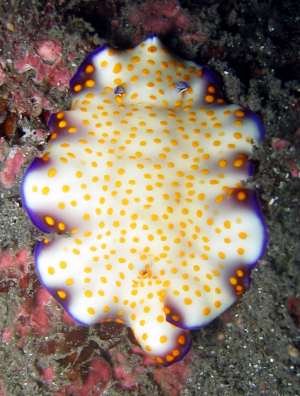
Dear Bill,
We are sending these pictures of what we believe is Risbecia pulchella.
This one was spotted in Reunion Island (western Indian Ocean), at a depth of approx 12 m last week (29 July 2004). The diving spot was Cap La Houssaye on the western coast of the island.We usually find them roaming around in the typical "trailing mode". This one was lonely and had this strange shape, his mantle was competely deployed.
Best regards.
Stefaan Dewulf
dive@rando-reunion.com
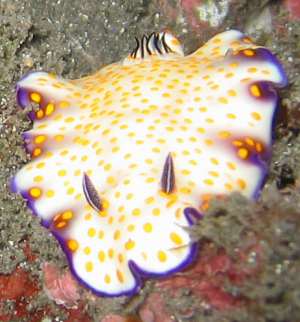
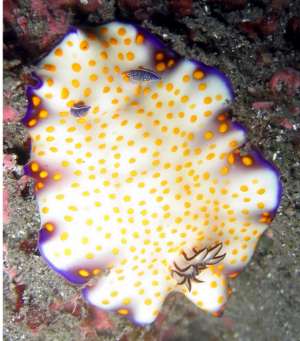
Thanks Stefaan,
I agree this is most likely to be Risbecia pulchella. The purple smudges on the mantle and the numerous gills both seem to be characteristic of this species when compared with R. ghardaqana. Sometimes you find chromodorids sitting 'flattened' like this, apparently resting.
Best wishes,
Bill Rudman.
Risbecia pulchella from Thailand
December 8, 2003
From: Spencer Huang
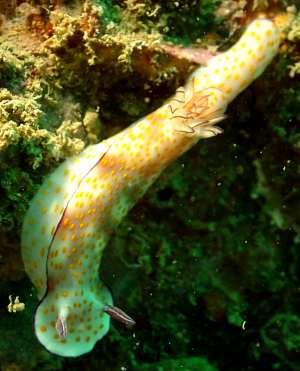
Dear Dr Bill,
I found this species at water of Thailand, Phuket. Was wondering if this species consider Chromodoris aspersa? However, the colour seem different. Could you help me to ID it?
Thanks in advance.
Spencer Huang
mambo189@yahoo.com
Huang, S., 2003 (Dec 8) Risbecia pulchella from Thailand. [Message in] Sea Slug Forum. Australian Museum, Sydney. Available from http://www.seaslugforum.net/find/11588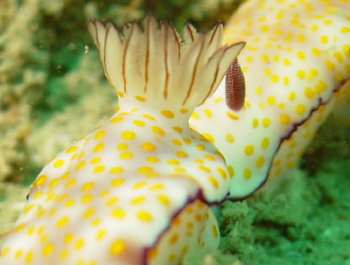
Dear Spencer,
Chromodoris aspersa has purple spots. This is Risbecia pulchella, one of a group of yellow-spotted species found in the Indo-West Pacific. Your second photo showing one animal closely following another is a very characteristic behaviour for species of Risbecia, Have a look at the page on 'trailing behaviour' for information.
Best wishes
Bill Rudman
Risbecia pulchella from Red Sea
May 22, 2003
From: Leo de Pee
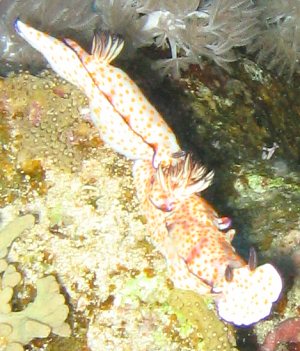
Dear all,
Photographed this bunch of nudies in the Red Sea on Gordon Reef (straits of Tiran), I could not make out the name of this nudibranch? Do you know?
Cheers,
Leo
ldepee@dc.com
Pee, L., 2003 (May 22) Risbecia pulchella from Red Sea. [Message in] Sea Slug Forum. Australian Museum, Sydney. Available from http://www.seaslugforum.net/find/9960Dear Leo,
This is a pair of Risbecia pulchella engaged in their characteristic trailing behaviour.
Bill Rudman
Risbecia pulchella from the Red Sea
May 17, 2003
From: Oren Lederman
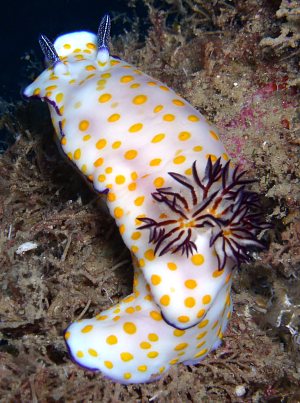
Dear Bill,
I started taking pictures with my new camera (the old pne had poor macro abilities), and posted them on the Israely Diving Forum. One of the divers said that you would probably be interested in this picture, so here it is ;)
I hope i'm posting it in the right place.
The picture was taken in the Red Sea, in a diving spot called The Pyramid (north part of Eilat Bay). The specimen was located on the inner pyramid (the pyramid is actually two pyramids) on its south side
Depth: 18 meters.
Date: 03 May 2003.
Size: It was big, something like 4 inches, but I'm not sure precisely
Oren Lederman
oren@rational.co.il
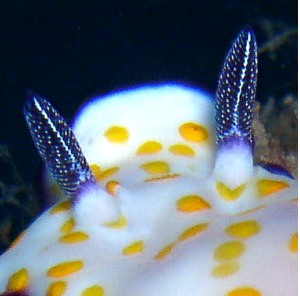
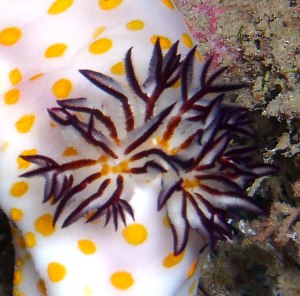
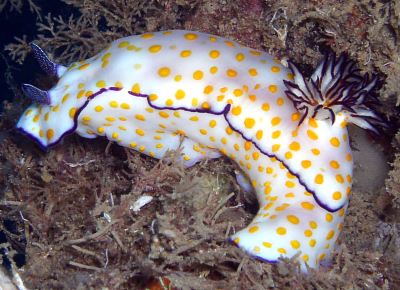
Dear Oren,
Thanks for the photos. It is definitely the right place to send them. We have been having a bit of confusion sorting out 3 yellow spotted species from the Red Sea so any help we can get to understand colour variation etc is very useful. I would also be very interested in any biological information - like animals feeding, or on a particular sponge, or laying eggs, mating etc. I have recently discussed the differences between the yellow-spotted species in a separate message. I am pretty sure your animal is Risbecia pulchella. Its relatively large size, the bluish rhinophores with a white line up the posterior edge, the bluish mantle edge, and the numerous gills, many of which have nmultiple branching, are all characters of that species. The only character missing is the diffuse purplish patches which are usually found on the mantle of Risbecia pulchella. Despite their absence, I would identify this as R. pulchella.
Best wishes,
Bill Rudman
Chromodoris hintuanensis or R. pulchella?
May 10, 2003
From: Asther M. Lau
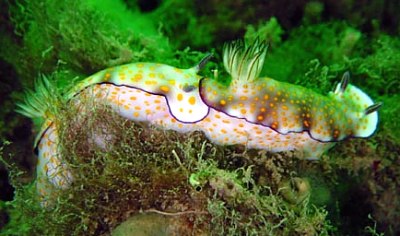
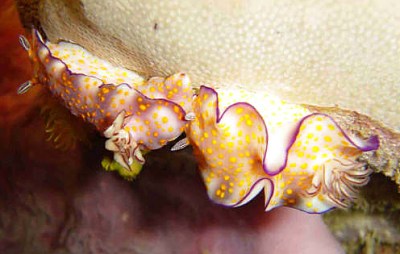
Hi...
Could these be a Chromodoris hintuanensis or Risbecia pulchella? I think it fits the latter.
The upper two pics were taken by one of my club members, Lim Eng Hoo.
Date: 16 Nov 2002
Location: Jarak Is., Lumut, Malaysia
I am still not quite sure what the lower picture is.
Photographer: Matthew Schnellen
Date:7 Dec 2002
Location: Jarak Is., Lumut, Malaysia
Please help to identify.
Thank you!
Asther
asther@scubadiveknit.com
Lau, A.M., 2003 (May 10) Chromodoris hintuanensis or R. pulchella?. [Message in] Sea Slug Forum. Australian Museum, Sydney. Available from http://www.seaslugforum.net/find/9835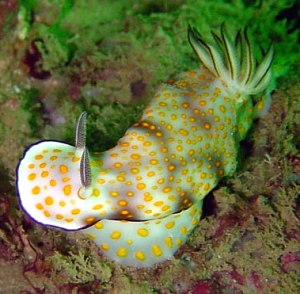
Dear Asther,
C. hintuanensis is easily identifiable by the few yellow spots which are ringed with purple. But one of the best ways of identifying a species of Risbecia is the trailing behaviour the animals in both the upper photos are exhibiting. These are Risbecia pulchella. So is the animal in the lower photo. Its widened 'veil' at the front of the head is an indication it is a Risbecia and the yellow spots, white line on rhinopores, and purple smudges on the mantle are all characters of R. pulchella.
Best wishes
Bill Rudman
Risbecia ghardaqana from Andaman Sea
April 8, 2003
From: Mary Jane Adams
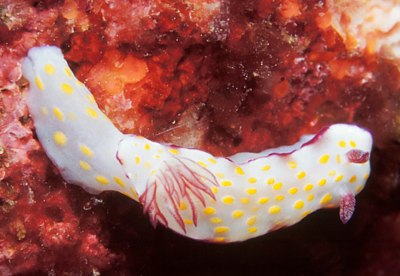
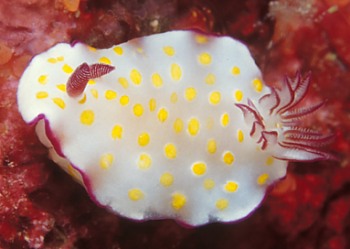
Hi Bill,
I photographed this nudibranch at Three Islets, Mergui Archipelago, Andaman Sea, Myanmar on Feb. 14, 2003. It was crawling around the reef at 5 meters. The notum was 15 mm long. At first I filed it with my Risbecia pulchella slides. However, after looking at images on the Sea Slug Forum, I think it looks more like Risbecia ghardaqana. What do you think?
Best regards,
Mary Jane
divepng@yahoo.com
Adams, M.J., 2003 (Apr 8) Risbecia ghardaqana from Andaman Sea. [Message in] Sea Slug Forum. Australian Museum, Sydney. Available from http://www.seaslugforum.net/find/9481Note added 12 October 2007: From number of gills I am pretty sure this is R. pulchella rather than R. ghardaqana.
Dear Mary Jane,
I think you might be right. In a separate message I am posting today I discuss the differenes between these two species. Your animal agrees in not having a the front of the mantle widened into a 'veil' and not having any diffuse purple marks on the mantle. It differs in having reddish-purple markings rather than deep blue. I think it is early days in separating these two species so I'll consider it to be Risbecia ghardaqana until the evidence says otherwise
Best wishes,
Bill Rudman
Risbecia pulchella from the Red Sea
April 8, 2003
From: Ilan Ben-Tov
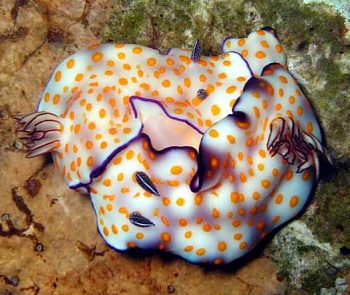
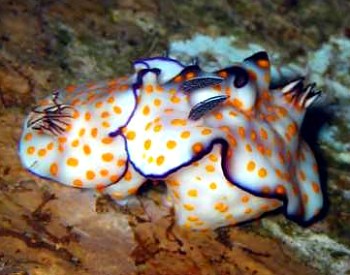
Dear Bill,
Here are two mating nudibranchs from Eilat, Red Sea. They were on a ship wreck at 20m depth. 28 December 2002
Ilan Ben-Tov
ilanbt@gilat.com
Tov , I., 2003 (Apr 8) Risbecia pulchella from the Red Sea. [Message in] Sea Slug Forum. Australian Museum, Sydney. Available from http://www.seaslugforum.net/find/9493Dear Ilan,
The white line on the rhinophores and the purplish marks on the mantle identify these as Risbecia pulchella. If you read the message I ma posting today you will see there are two very similarly coloured species. Any photos you have of yellow-spotted animals laying eggs would be of interest, and any photos you have of yellow-spotted slugs without the dull purplish marks on the mantle would be of interest.
Best wishes,
Bill Rudman
Risbecia pulchella from the Andaman Sea
April 8, 2003
From: Mary Jane Adams
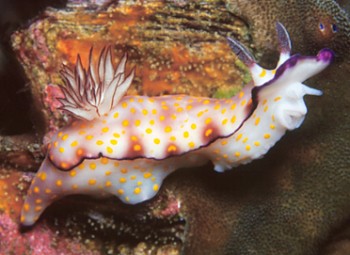
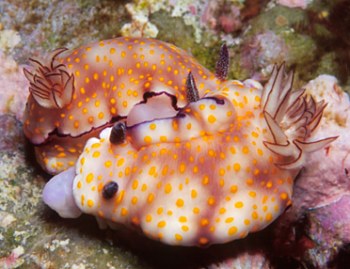
Hi Bill,
I saw lots of Risbecia pulchella during my recent dive trip to the Andaman Sea. Many of them were exhibiting trailing behavior. They seem to be more common than R. tryoni in this area. The attached images are from Black Rock, Mergui Archipelago, Myanmar. The slug with the single rhinophore was photographed at 5 meters on Feb. 15, 2003.
This anomaly seems to be a fairly common in otherwise healthy-looking nudibranchs. I guess it isn't much of a handicap. I photographed middle and lower images at the same divesite on Feb. 26, 2003. The pair are engaged in mating behavior. I think the one standing on its tiptoes is just sniffing around.
Best regards,
Mary Jane
divepng@yahoo.com
Adams, M.J., 2003 (Apr 8) Risbecia pulchella from the Andaman Sea. [Message in] Sea Slug Forum. Australian Museum, Sydney. Available from http://www.seaslugforum.net/find/9480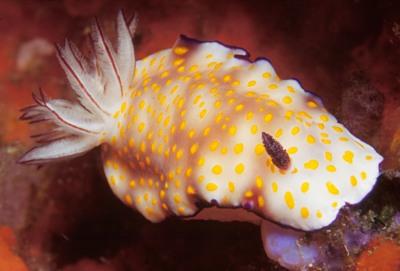
Thanks Mary Jane,
The one in the photo alongside shows the gill branching that Gohar & Aboul-Ela describe for this species [see my message].
Best wishes,
Bill Rudman
Re: Risbecia ghardaqana trailing
April 8, 2003
From: Erwin Koehler
Dear Bill,
Concerning the message about Risbecia ghardaqana. Even at the risk of getting on your nerves, why should this one, with the exact outlook of R. pulchella be R. ghardaqana? I have enough troubles separating this two species in the Red Sea. To tell the truth, I have NO criteria to distinguish them, "large" or "larger" yellow spots might be anything, but no EXACT criteria.
Erwin
Erwin@medslugs.de
Dear Erwin,
Sorry it's taken me a while to answer this. I haven't been ignoring it - its just taken a while to prepare. I had recently been thinking that these two 'species' had got out of control on the Forum and was in the process of trying to sort them out, so your message was timely. One of the advantages of having lots of photos on the Forum is that problems like this certainly can't stay hidden long. In a separate message, you will see I feel that most of the animals I have been tentatively calling R. ghardaqana on the Forum almost certainly R. pulchella.
Best wishes,
Bill Rudman
Risbecia ghardaqana trailing
March 29, 2003
From: Sarah Heaney
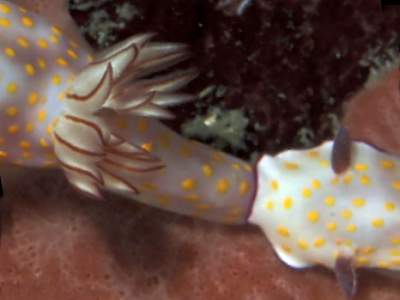
Dear Bill,
After reading the page on Risbecia ghardaqana I thought you may be interested in the following photos showing the trailing behaviour.
The photos were taken on 11/12/02 at South Rock, McLeod Island, Burma [Myanmar]. Max depth of the dive was 24.4 m, but not sure what depth the nudi was at
Regards
Sarah
sarahlheaney@hotmail.com
![]()
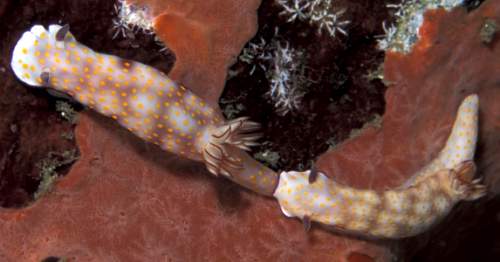
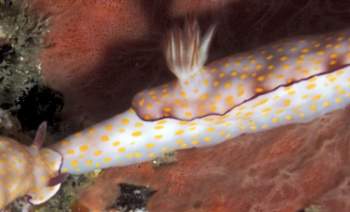
Note added 8 April 2003: Re-identified as Risbecia pulchella. See message.
Thanks Sarah,
It is certainly a strange behaviour. From the photo alongside we can see that this species does not always have the purple edge to the foot which is clearly visible in some other photos on the Forum.
Best wishes,
Bill Rudman
Risbecia ghardaqana - 'trailing' behaviour
March 2, 2003
From: Larry Dupriest
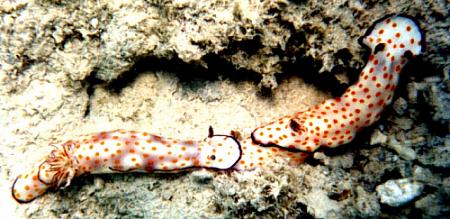
Dear Bill,
These photos are from Summer, mid June 2001
Starting from the shore, the sandy bottom changes to outcrops of dead coral covered with a layer of fine seaweed(?). The depth is a fairly constant 2-3 feet until the reef's edge (dark blue in photo). The reef drops vertically for about 75 feet. The water is crystal clear with bottom details easily visible. It is a wall of live coral varieties and countless species of individual and schooling fish.
These nudi's were found in about 2 feet of water where the sandy bottom meets the darker green water in the photo, about 50 feet from shore.
I observed them for about 15 minutes as they crawled along the bottom, then left them undisturbed. Is this their mating posture or is the one in back just hungry? Also, I don't know the species.
Larry Dupriest
dgdupriest@gtis.net
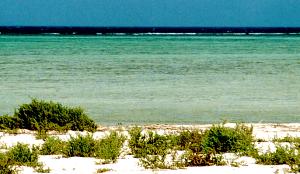
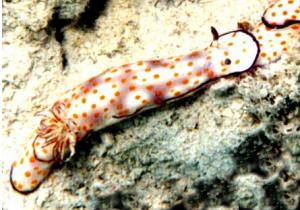
Note added 8 April 2003: Re-identified as Risbecia pulchella. See message.
Dear Larry,
Firstly I would appreciate some locality data. Is it the same as for Chromodoris quadricolor in your earlier message - 'along the Red Sea shoreline about 100 km north of Yanbu, Saudi Arabia (near the Yanbu Cement Plant)' - although that was summer of 2000?
With a locality your message becomes an important piece of scientific information. Your animal is Risbecia ghardaqana. The 'following' or 'trailing' behaviour is classic behaviour for all species of the chromodorid genus Risbecia. We now have photos on the Forum, of most of the species in the genus doing it. Other chromodorids don't do this so the value or reason for the behaviour is unknown.
Best wishes,
Bill Rudman
Risbecia ghardaqana from sthn Thailand
January 25, 2003
From: Priscilla Yeo
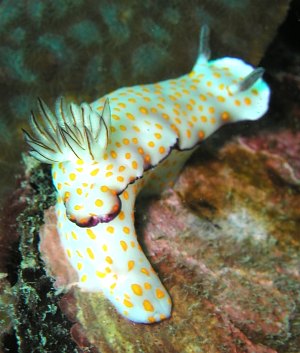
Here is another nudibranch from southern Thailand that I have a problem trying to id.
Laoliang Yei, Trang, south Thailand. depth between 6-8 meters. Picture taken on 2nd January 2003
I am 99% sure that this is a Risbecia pulchella, but I am curious as to why this particular creature seemed to have lost most of its distinctive brownish honeycomb marking on its mantle. I have seen other specimens of R. puchella with typical colouring at the same site, but this little fella just seem to be a wee bit washed out...
Priscilla
prisla@singnet.com.sg
Yeo, P., 2003 (Jan 25) Risbecia ghardaqana from sthn Thailand. [Message in] Sea Slug Forum. Australian Museum, Sydney. Available from http://www.seaslugforum.net/find/8884Note added 8 April 2003: Re-identified as Risbecia pulchella. See message.
Dear Priscilla,
If you look at the messages concerning both the small spotted Risbecia pulchella and the larger spotted Risbecia ghardaqana, it appears that both species occur in Thailand. It seems that as we learn more about the fauna of the northeastern Indian Ocean [Andaman Sea], we find it has much in common with the so-called endemic fauna of the northwestern Indian Ocean. I suspect this animal is Risbecia ghardaqana.
Best wishes,
Bill Rudman
Re: Risbecia pulchella vs. ghardaqana
April 6, 2002
From: Ron Velarde
Dear Bill/ Erwin,
Is that a purple parasitic copepod just posterior to the gills in the upper photo?
Ron Velarde
NB: My new email address is:
rvelarde@sandiego.gov
Velarde, R., 2002 (Apr 6) Re: Risbecia pulchella vs. ghardaqana. [Message in] Sea Slug Forum. Australian Museum, Sydney. Available from http://www.seaslugforum.net/find/6683Thanks Ron,
It certainly is a copepod.
Bill Rudman
Risbecia pulchella or ghardaqana (2)
April 5, 2002
From: Erwin Koehler
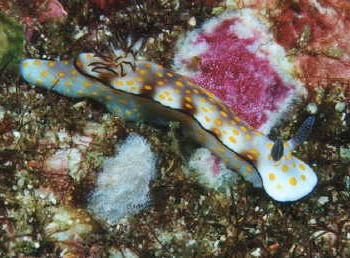
Dear Bill,
To accompany my other message, here is another photo of a Risbecia from Thailand, with a few large yellow spots. Is it R. ghardaqana?
Data: ek117821 length 32mm, depth 17m, Racha Noi Island, divesite "Plateau", Dec. 14, 2000
Erwin Koehler
Erwin@medslugs.de
Koehler, E., 2002 (Apr 5) Risbecia pulchella or ghardaqana (2). [Message in] Sea Slug Forum. Australian Museum, Sydney. Available from http://www.seaslugforum.net/find/4192Note added 8 April 2003: Re-identified as Risbecia pulchella. See message.
Thanks Erwin,
Bill Rudman
Risbecia pulchella vs. ghardaqana
April 5, 2002
From: Erwin Köhler
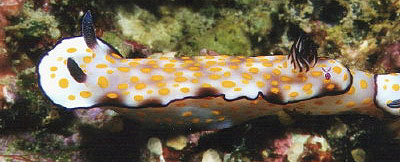
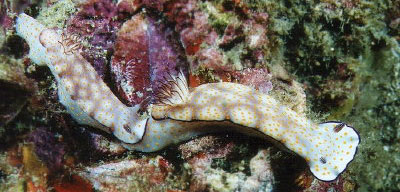
Dear Bill,
Attached are 2 shots from Thailand, one with the typical look of Risbecia pulchella [Lower], one with very large spots looking like Risbecia ghardaqana [Upper].
Data:
Upper: depth 19m, size 45mm, Racha Yai Island, 16 Dec. 2000
Lower: depth 14m, size 27+34mm, Koh Ha Yai Island, 27 Dec. 2000
Erwin
Erwin@medslugs.de
Köhler,E., 2002 (Apr 5) Risbecia pulchella vs. ghardaqana. [Message in] Sea Slug Forum. Australian Museum, Sydney. Available from http://www.seaslugforum.net/find/5853Dear Erwin,
Thanks for these photos. Basically I can't say whether the big-spotted one is R. ghardaqana with a purple network on the mantle, or a R. pulchella with large spots. R. ghardaqana in thwe western Indian Ocean seems to lack the purple network we see in R. pulchella but I don't know if that is a variable character in the species or not. We clearly have a bit to learn about these animals. It would be very useful to know the usual things I ask about - what they eat, what their eggs look like etc., to see if we can find some biological differences.
Best wishes,
Bill Rudman.
Risbecia pulchella from Bali
April 4, 2002
From: Stuart Hutchison
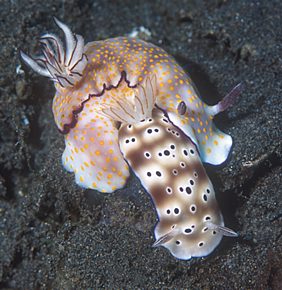
Bill,
Here's Risbecia pulchella from Bali, Indonesia on 14 Oct 2001. Depth 7m, lengths around 80mm each. Whilst there were dozens of Risbecia tryoni, this was the only R. pulchella we saw in 90 dives in the area.
Seems this is another occasion to prove the similarity between their 'chemical attractants'.
Stuart.
stuart@stuarthutchison.com.au
Hutchison, S., 2002 (Apr 4) Risbecia pulchella from Bali. [Message in] Sea Slug Forum. Australian Museum, Sydney. Available from http://www.seaslugforum.net/find/6283Thanks Stuart,
Mike Miller's observations, and yours, suggest that these two species seem to have difficulty in distinguishing species - or else we have got the species concept wrong in this genus. Very interesting.
Best wishes,
Bill Rudman
Risbecia ghardaqana from the Red Sea
January 31, 2002
From: Jim Anderson
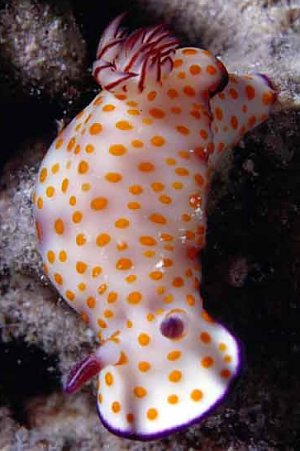
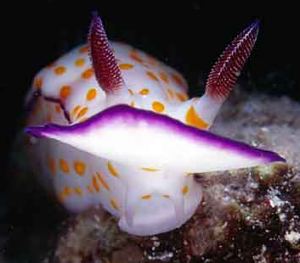
Dear Dr. Rudman,
Attached are a couple of images of Risbecia ghardaqana you may wish to add to the forum.
This animal was found 'trailing' another on Jackson Reef in the Straits of Tiran in the Red Sea in October 1998 at 20 M.
Kind regards,
Jim A
jander4454@aol.com
Anderson, J., 2002 (Jan 31) Risbecia ghardaqana from the Red Sea. [Message in] Sea Slug Forum. Australian Museum, Sydney. Available from http://www.seaslugforum.net/find/6123Note added 8 April 2003: Re-identified as Risbecia pulchella. See message.
Thanks Jim,
Always good to get more photos of these species which are apparently endemic to a small geographic area. It gives us a better idea of colour variation, if any, in the species.
Best wishes,
Bill Rudman
Is this Risbecia ghardaqana?
March 14, 2001
From: Doug Segar


I have attached two images of a slug photographed in Lembeh Strait, Sulawesi, Indonesia. It looks very like one color form of Risbecia ghardaqana on the site but this species is listed as Red Sea. Is this Risbecia ghardaqana?
Doug Segar
dsegar@reefimages.com
Segar, D., 2001 (Mar 14) Is this Risbecia ghardaqana?. [Message in] Sea Slug Forum. Australian Museum, Sydney. Available from http://www.seaslugforum.net/find/3848Dear Doug,
I think the image on the Risbecia ghardaqana page it looks like is the lower photo in Gordon Smith's message which is of R. pulchella. I think your animal is probably a form of R. pulchella. It looks quite like Valda Fraser's photo from South Africa. Neither your photos nor Valda's are 'typical' photos of R. pulchella but they both have a washy purple over the mantle which doesn't occur in R. ghardaqana. The only way to be sure would be to look at the anatomy of some specimens, but as a reasoned guess i would say they are a form of R. pulchella.
best wishes,
Bill Rudman
Risbecia pulchella - range extension
March 14, 2001
From: Michael D. Miller
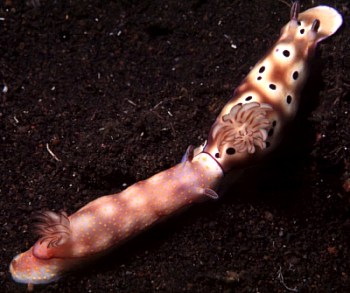
Dear Bill
Attached you will find a photo exhibiting "trailing" behavior by two different species of Risbecia, Risbecia pulchella [yellow spots] and Risbecia tryoni [purple spots]. Perhaps the most significant aspect of the image is a further southerly range extension of Risbecia pulchella from Thailand (Sea Slug Forum) into Indonesian waters.
Location: Tulamben, Bali, Indonesia
Date: Oct. 2000
Depth: 20 ft.
Photographer: Michael Miller
Cheers;
Mike
mdmiller@cts.com
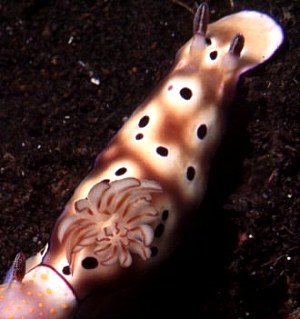
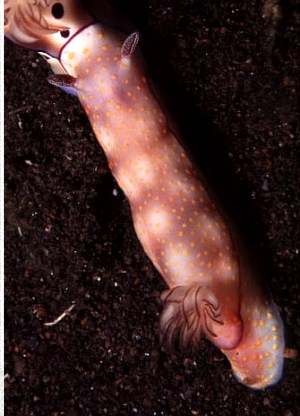
Dear Mike,
A very interesting photo [I have also posted larger versions of each animal from the photo]. I guess the trailing happened in a dish? It suggests the chemical attractant which apparently causes 'trailing' in species of Risbecia is not that different between species. It is also nice to get a fuller idea of the distributions of some of these species we thought were restricted to the western Indian Ocean.
Best wishes,
Bill Rudman
Risbecia pulchella without gills
January 12, 2001
From: Valda Fraser
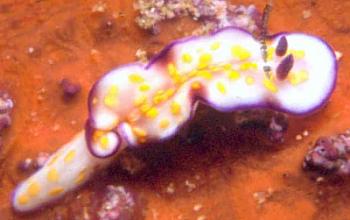
Dear Bill
Risbecia pulchella is very common along our coast. This one is not going to win a beauty contest! I hope it'll survive!
Locality: Aliwal Shoal, Umkomaas, south coast KwaZulu-Natal, SOUTH AFRICA, 15m
Date: Jan 2001
Size: 15mm
Regards
Valda Fraser
valda fraser@mweb.co.za
Fraser, V., 2001 (Jan 12) Risbecia pulchella without gills. [Message in] Sea Slug Forum. Australian Museum, Sydney. Available from http://www.seaslugforum.net/find/3507Dear Valda,
It seems these animals can survive quite a lot. Ther are not too many fish that could survive without their gills or land animals withour their lungs but a survivor such as this seems to confirm that they do quite a bit of oxygen exchange through their body wall.
Do all your Risbecia pulchella look like this? The spots are quite a bit larger than 'typical' R. pulchella, quite similar in fact to Risbecia ghardaqana.
Best wishes,
Bill Rudman
Risbecia pulchella from Oman
October 30, 2000
From: Gordon T. Smith
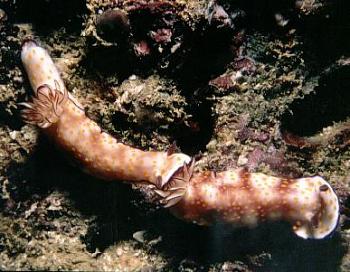
To accompany my message about possible Risbecia pulchella from northern Oman, I have included a photo of a pair of Risbecia pulchella that I photographed near Muscat (Oman) 2 years ago.
Gordon Smith
aquashot@emirates.net.ae
Smith, G.T., 2000 (Oct 30) Risbecia pulchella from Oman. [Message in] Sea Slug Forum. Australian Museum, Sydney. Available from http://www.seaslugforum.net/find/3262Thanks Gordon,
Bill Rudman.
Risbecia from the Seychelles
November 12, 1999
From: Dick Ballendux
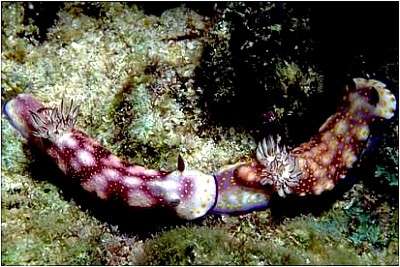
Dear Mr. Rudman,
Included are two images of which I'd like to have a confirmation or correction on their subject,s identity (if possible). The sources that I have at my disposal don't give me a 100% certainty.
The first one depicts a flatworm, that I've so far identified as a Pseudoceros lindae. I just haven't seen a picture of it yet that shows the same clear characteristics.
The second one, is dated 3 June 1998.
Taken in the Seychelles, Sisters Rock. Don't know the depth, but must be quite shallow. Rocky bottom, covered with algae, sponges, some coral. Considering the two nudibranchs attached and their colourful pattern I'd say they're Risbecia imperialis; but not sure....
Both photo's were taken by yours truly; admiring this impressive Forum,
Best regards,
Dick Ballendux
PS: My Indo-Pacific gallery can be visited at: http://www.library.tudelft.nl/~dball
(Just an enthusiastic, beginning uw-photographer).
d.ballendux@bk.tudelft.nl
Ballendux, R., 1999 (Nov 12) Risbecia from the Seychelles. [Message in] Sea Slug Forum. Australian Museum, Sydney. Available from http://www.seaslugforum.net/find/1518Dear Dick,
I'm afraid I have to draw the line at sea slugs - I just don't have enough time. Today I also received queries on snails from the Mediterranean and N.America and landslugs from Australia. I suggest you look at my Flatworm page for contacts.
Your nudibranchs are definitely Risbecia and are doing the 'trailing' or 'queueing' behaviour so typical of the genus. Your animal is the Indian Ocean species Risbecia pulchella.
Congratulation on the beautiful photos on your website.
Best wishes,
Bill Rudman
Risbecia pulchella from Thailand
April 12, 1999
From: Bill Rudman
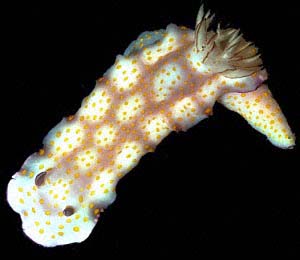
Since posting the information on Risbecia pulchella I have found this photo of David Brunckhorst's of a specimen he photographed in southern Thailand which considerably extends the range of this species from the western Indian Ocean, where it is quite common, to the northeastern side.
The locality data is : Phi Phi Is., Southern Thailand, 16m, Coll:D.J.Brunckhorst.
Thanks David for the use of your photograph,
Best wishes,
Bill Rudman.
'Trailing' in Risbecia pulchella
April 11, 1999
From: Bill Rudman
Here are some pictures of the East African species Risbecia pulchella exhibiting the 'trailing' behaviour mentioned by Erwin Koehler for Risbecia tryoni a few days ago.
Bill Rudman.
'Trailing' in Risbecia ghardaqana
April 9, 1999
From: Erwin Koehler
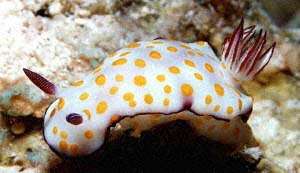
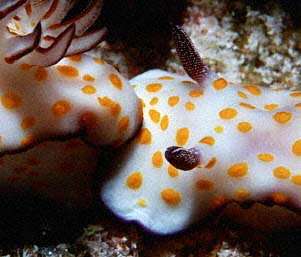
Dear Bill,
Following yesterday's message, here is a picture of another species of Risbecia, Risbecia pulchella showing trailing behaviour.
Red Sea, Egypt, 1996
Erwin
Medslugs.Koehler@t-online
Koehler, E., 1999 (Apr 9) 'Trailing' in Risbecia ghardaqana. [Message in] Sea Slug Forum. Australian Museum, Sydney. Available from http://www.seaslugforum.net/find/764Note added 8 April 2003: Re-identified as Risbecia pulchella. See message.
Dear Erwin,
Thanks for the rapid response. I am pretty sure that your photos are of Risbecia ghardaqana which is endemic to the Red Sea. I will put up some photos of Risbecia pulchella, from East Africa as soon as I can. It has much smaller spots.
Best wishes,
Bill Rudman.
